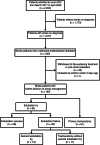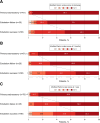Airway management and functional outcomes in intubated patients with ischemic stroke
- PMID: 39779973
- PMCID: PMC11711646
- DOI: 10.1038/s41598-025-85489-y
Airway management and functional outcomes in intubated patients with ischemic stroke
Abstract
We investigated the functional outcomes in ischemic stroke patients who underwent endotracheal intubation according to airway management (i.e., extubation success, extubation failure, primary tracheostomy) at multiple time points. Patients were classified into three groups: extubation success, extubation failure, and primary tracheostomy. Their functional outcomes were compared at hospital discharge, 3-month, and 1-year. Out of 165 ischemic stroke patients, 84 (50.9%) underwent extubation attempt and 81 (49.1%) underwent primary tracheostomy. Among the patients who underwent extubation, 26 (31.0%) experienced extubation failure. The extubation success group had a higher rate of achieving a favorable functional outcome (modified Rankin Scale 0-4) compared to the extubation failure group at hospital discharge (adjusted odds ratio [aOR] 3.93; 95% CI, 1.33-13.1; p = 0.018) and at 3-month (aOR 5.67; 95% CI 1.79-19.8; p = 0.004), but not at 1-year (aOR 2.99; 95% CI 0.96-9.68; p = 0.061). The primary tracheostomy group had a significantly lower rate of achieving a favorable functional outcome at all time points compared to the extubation failure group. These findings suggest that a condition suitable for an extubation attempt may be a more important 1-year prognostic indicator than extubation failure. Despite its limitations, this study suggests that the clinical condition prompting primary tracheostomy may outweigh extubation failure as a determinant of 1-year prognosis. However, prospective studies are needed to validate it and clarify its clinical implications.
Keywords: Cerebral infarction; Extubation failure; Intensive care unit; Intubation; Neurocritical care.
© 2025. The Author(s).
Conflict of interest statement
Declarations. Competing interests: The authors declare no competing interests.
Figures



Similar articles
-
Tracheostomy, Extubation, Reintubation: Airway Management Decisions in Intubated Stroke Patients.Cerebrovasc Dis. 2017;44(1-2):1-9. doi: 10.1159/000471892. Epub 2017 Apr 11. Cerebrovasc Dis. 2017. PMID: 28395275
-
Airway Management in Microvascular Reconstruction of the Oral Cavity: Is Immediate Extubation Possible?J Oral Maxillofac Surg. 2025 Feb;83(2):222-230. doi: 10.1016/j.joms.2024.10.014. Epub 2024 Oct 31. J Oral Maxillofac Surg. 2025. PMID: 39549725
-
Frailty and invasive mechanical ventilation: association with outcomes, extubation failure, and tracheostomy.Intensive Care Med. 2019 Dec;45(12):1742-1752. doi: 10.1007/s00134-019-05795-8. Epub 2019 Oct 8. Intensive Care Med. 2019. PMID: 31595352
-
Laryngeal mask airway for airway control during percutaneous dilatational tracheostomy.Anaesth Intensive Care. 2011 Nov;39(6):1009-13. doi: 10.1177/0310057X1103900605. Anaesth Intensive Care. 2011. PMID: 22165351 Review.
-
Tracheal extubation.Respir Care. 2014 Jun;59(6):991-1002; discussion 1002-5. doi: 10.4187/respcare.02926. Respir Care. 2014. PMID: 24891203 Review.
References
-
- Lahiri, S. et al. Mechanical ventilation for acute stroke: A multi-state population-based study. Neurocrit. Care23, 28–32. 10.1007/s12028-014-0082-9 (2015). - PubMed
-
- Sonneville, R. et al. What is the prognosis of acute stroke patients requiring ICU admission?. Intensive Care Med.43, 271–272. 10.1007/s00134-016-4553-7 (2017). - PubMed
-
- de Montmollin, E. et al. Pneumonia in acute ischemic stroke patients requiring invasive ventilation: Impact on short and long-term outcomes. J. Infect.79, 220–227. 10.1016/j.jinf.2019.06.012 (2019). - PubMed
-
- Alsherbini, K. et al. Predictors for tracheostomy with external validation of the stroke-related early tracheostomy score (SETscore). Neurocrit. Care30, 185–192. 10.1007/s12028-018-0596-7 (2019). - PubMed
Publication types
MeSH terms
Grants and funding
LinkOut - more resources
Full Text Sources
Medical

